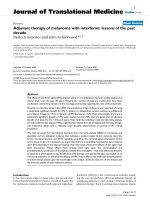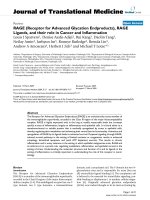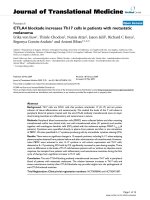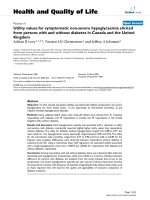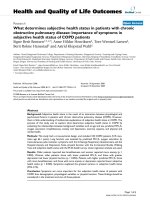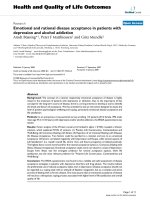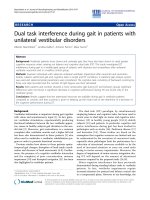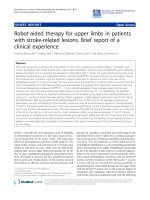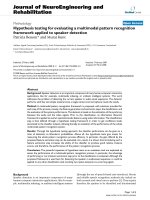Báo cáo hóa học: " Robot-aided therapy for upper limbs in patients with stroke-related lesions. Brief report of a clinical experience" ppt
Bạn đang xem bản rút gọn của tài liệu. Xem và tải ngay bản đầy đủ của tài liệu tại đây (222.12 KB, 6 trang )
SHOR T REPOR T Open Access
Robot-aided therapy for upper limbs in patients
with stroke-related lesions. Brief report of a
clinical experience
Federica Bovolenta
1*†
, Patrizio Sale
2†
, Valentina Dall’Armi
3
, Pierina Clerici
1
and Marco Franceschini
2
Abstract
This study was aimed at verifying the improvement on the motor impairment and functionality in 19 patients with
chronic hemiparesis after stroke treated with a robot-aided rehabilitation protocol using the ReoGo™ system (Motorika
Medical Ltd, Israel), and at evaluating the persistence of the effects after 1 month. The study also focused on the actual
possibility of administering the robot-aided therapy with the ReoGo™ for the upper limbs and on the patients’ degree
of acceptance and compliance with the treatment. Subjects underwent an assessment prior to the start of the
rehabilitation project (T-1), one at the start (T0), one at the end of the treatment (T1) and one after one month from the
end of the treatment (T2). The following tests were administered: (i) Fugl-Meyer (FM) upper limb; Ashworth scale (AS);
Functional Independence Measure (FIM™) (T-1 - T2); (ii) strength evaluation; Visual Analogue Scale (VAS) for pain;
Frenchay Arm test (FAT); Box and Block test (BBT); Timed Up and Go (TUG) test (T0 - T2). Additionally, the Euro-QoL
questionnaire and a VAS for the treatment satisfaction were administered to the subjects. Non-statistical difference of
scores at T-1 and T0 on almost the entire battery of tasks suggested a stable patients’ performance prior to the start of
the rehabilitation. With the exception of the Medical Research Council (MRC) and the AS sub-scales measuring -as
appropriate- strength and spasticity of the shoulder, triceps and wrist, all scores showed a significant increase between
T0 and T1. The improvement on the pain could not be proved significant (p = 0.10). A significant increase between T0
and T2 was found for all assessment scores, with the exception of the MRC for external shoulder rotators (p = 0.05) and
of the AS for shoulder (p = 0.32) and wrist (p = 0.08). Substantial stability was observed between T1 and T2. Patients
were capable of completing the treatment and showed good participant satisfaction. This pilot study led to the finding
of a clinical improvement and excellent patients compliance. It is possible that the learning process experienced by the
patients was robot-dependent, especially in consideration of the general maintenance of the achievements observed
on all activities.
Stroke is currently the most important cause of disability
in industrialized countries; it is the main cause of func-
tional impairment of t he upper limbs, with important
effects on participation to activities of daily living [1]. The
upper limb s remain non- functional at 6 months post
stroke in 30%-66% of cases, while only 5%-20% of the
patients fully recover upper limbs functionality [2]. In the
last 10 years rehabilitative therapeutic interventions have
been developed to provide the best possible treatment
both in acute and chronic phases. In this context, research
showed that an effi cient treatment must be intensive and
specific [ 3], repetitive, funct iona l and mot ivating for the
individual [4,5] in order to allow for a continuous progres-
sion in the process of learning, acquisition and generaliza-
tion [6,7]. The development of robot-aided tools for
neurological rehabilitation is a very stimulating prospective
when considering their highly rehabilitative potentials
[8-10]. The objective of this study is to verify the improve-
ment on the m otor impairment and functionality after a
robot-aided rehabilitation treatment with the ReoGo™
system and the persistence o f the effects after 1 month.
A focus will also be towards the actual possibility of
administering the robot-aided therapy for the upper limbs
with the ReoGo™ system and on the patients ’ degree of
acceptance and compliance with the treatment. Subjects
with stroke (chroni c hemiparesis) and with the following
* Correspondence:
† Contributed equally
1
Medicine Rehabilitation NOCSAE Hospital AUSL of Modena, Modena, Italy
Full list of author information is available at the end of the article
Bovolenta et al. Journal of NeuroEngineering and Rehabilitation 2011, 8:18
/>JNER
JOURNAL OF NEUROENGINEERING
AND REHABILITATION
© 2011 Bovolenta et al; licensee BioMed Central Ltd. This is an Open Access article dis tributed under the terms of the Creative
Commons Attribution Lice nse ( which permits unrestricted use, distribution, and
reproduction in any medium, provided the original work is properly cited.
inclusion criteria were prospectively recruited into this
“before-after” study: (a) first acute event of cerebrovascular
stroke; (b) unsuccessful conclusion of a previous rehabili-
tation program (with no evident improvement of motility
recovery); (c) discontinuation from any upper limb rehabi-
litation treatment for at lea st 1 month prior to the first
visit. The following subjects were not included in the
study: (a) patients with severe cognitive, linguistic or per-
ceptive impairment (Mini Mental State Examination
(MMSE) < 24); (b) patients who refused consent to the
study; (c) patie nts who interrupted the robotic treatment
for more than 3 days. If the treatment was interrupted for
less than 3 days, all missed sessions were recovered. All
recruited patients signed an informed consent. Each
patient underwent a treatment cycle using the ReoGo™
sys tem. The treatment consi sted of a total of 20 sessions
last ing 45 minutes each, 5 days a week, for a total period
of 4 weeks; the rehabilitative protocol designed by us con-
sisted of exercises aimed at improving both movement
type (i.e., the joints involved, with a proximal-distal pro-
gression) and mode of execution of the movement itself,
with progression from passive mo vement to free move-
ment. Forearm support was used during treatment. Speci-
fic tasks are described in Table S1, Additional file 1.
The first visit took p lace 1 month prior to the start of
the treatment (T-1). Following visit were scheduled:
immediately before the start of the treatment (T0),
immediately after the end of the treatment period (T1),
and after 1 month (T2) during which period patients
underwent no specific rehabilitation for the upper limb.
The assessment tasks were: Fugl-Meyer (FM) for upper
limb with its subtest: M otor function, Sensation, Passive
Joint Moti on, Joint Pain. [Lindmark, Hamrin 1988)
[11,12]; Strength evaluation of 10 muscles, according
to the Medical Research Council (MRC) criteria [13];
Ashworth (AS) elbow, wrist and shoulder sub-scales for
spasticity [14]; Visual Analogue Scale (VAS) for upper
limb pain; Frenchay Arm test (FAT) [15]; Box and Block
test (BBT) [16]; Functional Independence Measure
(FIM™) motor sub-score [17,18]. In addition, subjects
underwent a comprehensive evaluation using the Timed
Up and G o (TUG) test [19]. Lastly, the Euro-QoL ques-
tionnaireforthequalityoflife[20,21]andaVASfor
treatment satisfaction were also administered to the sub-
jects. The evaluations timeline is detailed in table 1.
Specific aims of this study were: (i) to verify that sub-
jects’ performance was stable prior to the start of the
robotic treatment. This was done by comparing the per-
formance at T-1 and T0 with regards to t he FM, FIM™
and AS; (ii) to det ect the improvement on subject’sclini-
cal status and its maintenance at 1 month after the com-
pletion of the rehabilitation program. This was done by
comparing the change in performance on all tests from
T0 to T1 and T2 and from T1 to T2. The Wilcoxon test
for paired data was applied to perform all time compari-
sons. The critical limit for significance was set at p <
0.05. The statistical so ftware STATA/SE Relea se 10 was
used to carry out all statistical evaluations.
Nineteen subjects were included in the study, 13
(68.42%) were males and 6 (31.58%) females; 7 indivi-
duals (36.84%) presented with left hemiparesis and 12
(63.16%) with right hemiparesis. The sample average age
was 55.74 ± 12.60 years, with a range of 26-71; the aver-
age time elapsed since the acute event was 57.37 ±
92.37 months, with a range o f 8-295 months. Table 2
summarizes descriptive, clinical and psychological sam-
ple information. The follow-up visit (T2) co uld not be
carried out on 3 patients because of difficulties encoun-
tered by their relatives in reaching the hospital.
Stability in the patients’ performance prior to the start
of the rehabilitative treatment, supported by the non-
statistical difference of scores at T-1 and T0 for all
tasks, with the exclusion of the motor FIM™ (p = 0.01),
was observed.
The improvement observed in the patients’ perfor-
mance from T0 to T1 reached statistical significance f or
the FM upper limb (p < 0.01) sub-scores, for the AS
elbow sub-scale (p < 0.01), for the motor FIM™ (p <
0.01), for all muscles’ stre ngth according to the MRC cri-
teria -with the exception of the external rotators o f the
shoulder (p = 0.18), triceps (p = 0.06), wrist flexors (p =
0.13) and extensors (p = 0.08)-, for the BBT (p < 0.01),
for the TUG test (p = 0.01), and for the FAT (p < 0.01).
Similarly, statistical evidence for an improvement from
T0 to T2 was found for the FM upper limb (p < 0.01),
for the AS elbow sub-scale (p = 0.01), for the motor
FIM™ (p < 0.01), for the VAS pain (p < 0. 01), for all
muscles’ strength -with the exception of the external
rotators of the shoulder (p = 0.05)-, for the BBT (p =
0.01), for the FAT (p < 0.01) and for the TUG test (p =
0.02). Statistical evidence in favor of a progressive
Table 1 Timeline of the evaluations performed on all
patients during the study period
Tests T-1 T0 T1 T2
Fugl-Meyer motor function XX X X
MRC* -X X X
Ashworth Scale XX X X
Visual Analogue Scale pain -X X X
Frenchay Arm Test -X X X
Box & Block Test -X X X
FIM™ motor XX X X
Time Up and Go Test -X X X
EURO-QoL* -X - X
Visual Analogue Scale satisfaction X -
*MRC: strength evaluation of 10 muscles, according to the Medical.
Research Council (MRC) criteria; EURO-QoL.
questionnaire on quality of life perception.
Bovolenta et al. Journal of NeuroEngineering and Rehabilitation 2011, 8:18
/>Page 2 of 6
improvement from T1 to T2 emerged for the motor
FIM™ (p = 0.01) and the VAS (p = 0.02). The percep-
tion of the quality of life, as measured by the Euro-QoL,
did not show statistically significant variations over time;
the VAS for patients’ treatment satisfaction had an aver-
age score of 98.68 ± 4.02. Table 3 summarizes the sam-
ple performance over time at all clinical tests.
The study showed a positive evolution of the limita-
tion of activity and functionality for all subjects.
ThesamplehadabaselineFMinlinewithotherstu-
dies (Table 3) [10,22,23] and so was the increase in FM
score (Lindmark and Hamrin) [10,22,23].
All subjects showed excellent compliance and remark-
able satisfaction, highlighted by the results of the VAS
rating and the absence of dropouts associated to intoler-
ance to treatment. The increase in the motor FIM™
and the decrease on the VAS for the pain might be du e
to different strategies developed by the patients for com-
pensating their motor deficits. This data is in accor-
dance with Lauretani [2010] who observed a functional
recovery aft er a rehabilitation treatment in patients dis-
charged to home [24]. The statistically significant
increase between T0 and T2 shows how the improve-
ment observed immediately after completion of the
rehabilitative protocol was maintained over time, even
though the sample under examination included subjects
in a stable disease stage. Our results are in accordance
with those of Bosecker 2010, who studied 111 indivi-
duals with chronic impairment caused by stroke and
trained with a robot [25]. Such a robot-guided treatment
must be task-oriented, functional and motivating for the
patient [4,5,23], and therefore capable of determining a
process of learning, acq uisition and generalization [6,7].
The use-dependent robot-aided inst ruments (intensive
and repetitive treatment) may favor functional reorgani-
zation phenomena, typical of neuronal plasticity [3,26].
Our experience i s also in line with studies [6,27] that
confirm how this type of treatment does not negatively
affect spasticity: in our sample, the elbow AS score was
reduced, while no change, nor an increase in spasticity,
was detected for the other joints [28]. The positive effect
observed on the quality and speed of the walking perfor-
mance, assessed through TUG both at T1 and T2, is
also interesting. This data conforms with Esquinazi
paper [29] . The results obtained from our study suggest
that a motor and functional recovery takes place and
can be interpreted as a possible result of the process of
adaptation. In addition, it was also pos sible to observe a
motor learning and generalization process, confirmed by
the baseline improvements observed at T1 and main-
tained until 1 month after (T2), an indication of the fact
that patients were not in a spontaneous recovery stage.
Further research with higher statistical power is neces-
sary. The enrolmen t of a control group would provide a
term of comparison for the identification of the time-
dependent effects, thus addressing the question of
whether improvements are therapy-dependent or effec-
tively acquired. Eventual relationships b etween clinical
outcome and potentially influential factors should be
explored. Stronger evidence would be beneficial when
coming to make the decision of using robotic devices as
an integral part of the rehabilitation team activities,
within a r ehabilitat ion project designed accordingly to
the specifications and objective requirements of each
patient. In this context, subjects at different disease
stages (i.e. patients in the acute and sub-acute phases)
should be considered in future research. Indeed, while
there are several studies with various robotic systems for
the upper limb in acute/sub-acute stroke patients
[30-32], only one study with ReoGo™ system in the
sub-acute phase [33] has been carried out so far. The
implementation of different protocols according to the
severity of the impairment should also be considered.
The results obtained in terms of recovery in functional-
ity and the restriction of participation, as well as in
patients’ compliance and operator sat isfaction, are
encour aging in spite of the limitations of this study. The
significant improvements found from the b aseline mea-
surements to the end of the treatment may be an
Table 2 Demographic, clinical and psychological sample
N % Mean ± Std.Dev
Time since Stroke 19 57.37 ± 92.37
Age 19 55.74 ± 12.60
Gender Males 13 68.42
Females 6 31.58
Affected Side Left 7 36.84
Right 12 63.16
Disease Severity Mild 9 47.37
Moderate 9 47.37
Severe 1 5.26
EURO-QOL
MOB Yes 3 15.79
No 15 78.95
Unknown 1 5.26
CP Yes 10 52.63
No 7 36.84
Unknown 2 10.53
AU Yes 3 15.79
No 15 78.95
Unknown 1 5.26
DD Yes 4 21.05
No 14 73.69
Unknown 1 5.26
AD Yes 8 42.11
No 10 52.63
Unknown 1 5.26
Bovolenta et al. Journal of NeuroEngineering and Rehabilitation 2011, 8:18
/>Page 3 of 6
Table 3 Performance at the clinical assessment tasks
T-1 (N = 19) T0(N = 19) T1 (N = 19) T2(N = 16)
Mean ± Std.
Dev.
Median Min;
Max
Mean ± Std.
Dev.
Median Min;
Max
Mean ± Std.
Dev.
Median Min;
Max
Mean ± Std.
Dev.
Median Min;
Max
Fugl-Meyer Test (n = 18) Upper Limb 31.33 ± 17.42 33.5 5; 54 31.21 ± 16.92 33 7; 55 40.37 ± 18.57 49
b
9; 62 41.75 ± 18.95 49.5
b
9; 63
Ashworth Scale (n = 18) Shoulder 0.67 ± 0.77 0.5 0;2 0.37 ± 0.6 0 0;2 0.16 ± 0.37 0 0; 1 0.25 ± 0.77 0 0;3
Elbow 1.67 ± 0.91 1.5 0;3 1.79 ± 0.98 2 0;3 1.26 ± 0.93 1
b
0;3 1.44 ± 1.03 1
b
0;3
Wrist 0.89 ± 1.02 1 0;4 1 ± 1 1 0;4 0.68 ± 0.67 1 0;2 0.63 ± 0.62 1 0;2
FIM™ (n = 16) Motor 80.63 ± 16.22 82 53; 126 82.26 ± 13.88 83
a
56; 126 85.21 ± 11.84 86
b
69; 126 85.94 ± 6.32 88.5
b
,
c
69; 91
Visual Analogue Scale Pain 22.05 ± 26.33 15 0;80 11.58 ± 20.21 0 0;75 0 ± 0
0
b,c 0;0
Medical Research Council, muscles’
strength criteria
Trapezius 3.37 ± 0.76 3 2;5 3.79 ± 0.79 4
b
3;5 3.94 ± 0.77 4
b
3;5
Deltoid 3.68 ± 0.58 4 2;4 4.37 ± 0.6 4
b
3;5 4.56 ± 0.63 5
b
3;5
Pectoralis
Major
3.74 ± 1.19 4 0;5 4.47 ± 0.77 5
b
2;5 4.75 ± 0.45 5
b
4;5
External
Rotatores
3.58 ± 1.12 4 0;5 4.11 ± 1.15 4
b
0;5 4.25 ± 1.29 5
b
0;5
Internal
Rotatores
32 ± 1.57 4 0;4 3.32 ± 1.57 4 0;5 3.56 ± 1.46 4 0;5
Biceps Brachii 3.95 ± 0.97 4 2;5 4.53 ± 0.61 5
b
3;5 4.81 ± 0.4 5
b
4;5
Triceps Brachii 3.74 ± 1.28 4 0;5 4.05 ± 1.08 4 1;5 4.31 ± 1.14 5
b
1;5
Flexor Carpi 3 4 0; 53 4 0;5 3.32 ± 1.67 4 0;5 3.63 ± 1.63 4
b
0;5
Extensor Carpi 2.84 ± 1.38 3 0;4 3.21 ± 1.51 4 0;5 3.5 ± 1.41 4
b
0;5
Latissimus
Dorsi
2.74 ± 1.24 3 0;4 3.47 ± 1.12 4
b
1;5 3.94 ± 1.06 4
b
1;5
Box & Block Test 11.89 ± 11.69 12 0;38 16.95 ± 15.6 17
b
0;45 17 ± 15.9 17
b
0;54
FrenchayArm Test 2.47 ± 1.81 3 0;5 3.26 ± 2.05 5
b
0;5 3.31 ± 1.96 4.5
b
0;5
Time Up and Go Test 18.58 ± 7.9 17 10; 40 17.47 ± 8.55 14
b
9; 38 16.25 ± 7.01 15
b
8;34
Bovolenta et al. Journal of NeuroEngineering and Rehabilitation 2011, 8:18
/>Page 4 of 6
indication of a clinical-functional improvement, thus a
presumed effectiveness of the REOGo™ instrument
[26,34-36]. In conclusion, further research with neuro-
imaging and/or TMS patterns, with an adequate control
group, will be imperative to confirm these results.
Additional material
Additional file 1: Reo Go Protocol. The specific rehabilitation tasks. The
assessment process is designed to view the patient’s ability to perform
specific exercises over time. The system is capable of measuring and
displaying the patient’s progress. The screen displays the activities of the
patient on the machine, according to exercise dates. The following
parameters can be changed: • Number of repetitions - how many
times the exercise will be repeated • Speed - Values range between 10%
and 200%. The 100% value is 5 degrees per second. • Force (the
resistance force of the joystick) - 3 possible values - High, Medium, and
Low. Low force will require less force from user to initiate movement. •
Motion mode - Guided, Initiated, Step Initiated, Follow assist or Free •
Scaling - Each exercise can be scaled according to patients’ comfortable
range of motion -i.e. stretched or squeezed from a center point. Values
range from 0% to 200% of the original exercise. • Random - Each
exercise can be run in Random mode, i.e. the computer selects the next
point randomly from the points of the exercise. • 2D/3D mode - for
every exercise, the radius of motion may be fixed (2D motion) or
changeable (3D motion). The system provides the following exercise
operating methods: • Guided mode - the patient is actively assisted by
the system. • Initiated mode - the patient initiates each trajectory
segment (between two successive recorded points) by himself,
overcoming a predefined force threshold and then is actively assisted by
the system for the rest of the segment • Step Initiated mode - similar
to Initiated, but each trajectory segment (between two successive
recorded points), is further divided to predefined “sub-segments ”
(3 degrees each) to overcome force threshold. • Follow Assist mode -
the handle moves at a slow speed towards the target. Once the user
applies force to the handle in the specified direction the speed will be
increased. • Free mode - the patient actively leads the movement by
himself. A summary of total training time is also displayed. Pressing the
individual dates will display a summary of training for the specific date.
Author details
1
Medicine Rehabilitation NOCSAE Hospital AUSL of Modena, Modena, Italy.
2
IRCCS San Raffaele Pisana, Rome, Italy.
3
Clinical and Molecular Epidemiology,
IRCCS San Raffaele Pisana, Rome, Italy.
Authors’ contributions
The overall design of the experiment was agreed upon by all authors. MF,
PS and FB designed the overall study. FB, MF and PC defined the motor
task. FB and PC selected the subjects and conducted all clinical evaluations.
FB, PC and PS programmed the robot, including the Robot Training
procedure, conducted all experiments and processed the data. VDA
performed the statistical analysis. FB, PS, and VDA wrote the manuscript. All
authors read and approved the manuscript.
Competing interests
The authors declare that they have no competing interests.
Received: 5 August 2010 Accepted: 9 April 2011 Published: 9 April 2011
References
1. WRITING GROUP MEMBERS, Lloyd-Jones D, Adams RJ, Brown TM,
Carnethon M, Dai S, De Simone G, Ferguson TB, Ford E, Furie K, Gillespie C,
Go A, Greenlund K, Haase N, Hailpern S, Ho PM, Howard V, Kissela B,
Kittner S, Lackland D, Lisabeth L, Marelli A, McDermott MM, Meigs J,
Mozaffarian D, Mussolino M, Nichol G, Roger VL, Rosamond W, Sacco R,
Sorlie P, Roger VL, Thom T, Wasserthiel-Smoller S, Wong ND, Wylie-Rosett J,
American Heart Association Statistics Committee and Stroke Statistics
Subcommittee: Heart disease and stroke statistics–2010 update: a report
from the American Heart Association. Circulation 2010, 121(7):e46-e215,
Epub 2009 Dec 17.
2. Kwakkel G, Kollen BJ, van der Grond J, Prevo AJH: Probability of regaining
dexterity in the flaccid upper limb. Impact of severity of paresis and
time since onset in acute stroke. Stroke 2003, 34:2181-86.
3. Kwakkel G, van Peppen R, Wagenaar RC, Wood Dauphinee S, Richards C,
Ashburn A: Effects of augmented exercise therapy time after stroke. A
meta-analysis. Stroke 2004, 35:2529-36.
4. Yavuzer G, Senel A, Atay MB, Stam HJ: “Playstation eyetoy games”
improve upper extremity-related motor functioning in subacute stroke:
a randomized controlled clinical trial. Eur J Phys Rehabil Med 2008,
44:237-44.
5. van Peppen RP, Kwakkel G, Wood-Dauphinee S, Hendriks HJ, van der
Wees PJ, Dekker J: The impact of physical therapy on functional
outcomes after stroke: what’s the evidence? Clin Rehabil 2004, 18:833-62.
6. Huang VS, Krakauer JW: Robotic neurorehabilitation: a computational
motor learning persective. J Neuroeng Neurorehab 2009, 6:5.
7. Krakauer JW: Motor learning: its relevance to stroke recovery and
neurorehabilitation. Curr Opin Neurol 2006, 19:84-90.
8. Mehrholz J, Platz T, Kugler J, Pohl M: Electromechanical and robot-assisted
arm training for improving arm function and activities of daily living
after stroke. Cochrane Database Syst Rev 2008, 4.
9. Kwakkel G, Kollen BJ, Krebs HI: Effects of robot-assisted therapy on upper
limb recovery after stroke: a systematic review. Neurorehabil Neural Repair
2008, 22:111-21.
10. Prange GB, Jannik MJ, Groothuis-Oudshoorn CG, Hermens HJ, Ijzerman MJ:
Systematic review of the effect of robot-aided therapy on recovery of
the hemiparetic arm after stroke. J Rehabil Res DEV 2006, 43:171-84.
11. Fugl-Meyer AR, Jääskö L, Leyman I, Olsson S, Steglind S: The post-stroke
hemiplegic patient. 1. a method for evaluation of physical performance.
Scand J Rehabil Med 1975, 7:13-31.
12. Lindmark B, Hamrin E: Evaluation of functional capacity after stroke as a
basis for active intervention. Validation of a modified chart for motor
capacity assessment. Scand J Rehabil Med 1988, 20:111-115.
13. Medical Research Council: Aids to the examination of the peripheral
nervous system. London: Her Majesty’s Stationery Office; 1976,
Memorandum n°45.
14.
Ashworth B: Preliminary trial of carisprodol in multiple sclerosis.
Practitioner 1964, 192:540-2.
15. Heller A, Wade DT, Wood VA, Sunderland A, Hewer RL, Ward E: Arm
function after stroke: measurement and recovery over the first three
months. J Neurol Neurosurg Psychiatry 1987, 50:714-719.
16. Mathiowetz V, Volland G, Kashman N, Weber K: Adult norms for the box
and block test for manual dexterity. Am J Occup Ther 1985, 39:386-91.
17. Tesio L, Granger CV, Perucca L, Franchignoni FP, Battaglia MA, Russel CF:
The FIM instrument in the United States and Italy: a comparative study.
Am J Phys Med Rehabil 2002, 81:168-176.
18. Functional Indipendent Measure: versione italiana. Manuale d’uso.
Ricerca Riabil; 1992:2(suppl):1-44.
19. Podsiadlo D, Richardson S: The timed “Up & Go": a test of basic
functional mobility for frail elderly persons. J Am Geriatr Soc 1991,
39:142-148.
20. Dorman PJ, Waddell F, Slattery J, Dennis M, Sandercock P: Is the Euroqol a
valid measure of health-related quality of life after stroke? Stroke 1997,
28:1876-1882.
21. Franceschini M, La Porta F, Agosti M, Massucci M: Is health-related-quality
oflife of stroke patients influenced by neurological impairments at one
year after stroke? Eur J Phys Rehabil Med 2010.
22. Lo AC, Guarino PD, Richards LG, Haselkorn JK, Wittenberg GF,
Federman DG, Ringer RJ, Wagner TH, Krebs HI, Volpe BT, Bever CT Jr,
Bravata DM, Duncan PW, Corn BH, Maffucci AD, Nadeau SE, Conroy SS,
Powell JM, Huang GD, Peduzzi P: Robot-assisted therapy for long-term
upper-limb impairment after stroke. N Engl J Med 2010, 362(19) :1772-83.
23. Casadio M, Giannoni P, Morasso P, Sanguineti V: A proof of concept study
for the integration of robot therapy with physiotherapy in the treatment
of stroke patients. Clin Rehabil 2009, 23:217-28.
24. Lauretani F, Saccavini M, Zaccaria B, Agosti M, Zampolini M, Franceschini M:
Rehabilitation in patients affected by different types of stroke. A one-
year follow-up study. Eur J Phys Rehabil Med 2010.
Bovolenta et al. Journal of NeuroEngineering and Rehabilitation 2011, 8:18
/>Page 5 of 6
25. Bosecker C, Dipietro L, Volpe B, Krebs HI: Kinematic robot-based
evaluation scales and clinical counterparts to measure upper limb motor
performance in patients with chronic stroke. Neurorehabil Neural Repair
2010, 24(1):62-9.
26. Posteraro F, Mazzoleni S, Aliboni S, Cesqui B, Battaglia A, Dario P, Micera S:
Robot-mediated therapy for paretic upper limbo f chronic patients
following neurological injury. J Rehabil Med 2009, 41:976-80.
27. Staubli Patricia, Tobias Nef, Verena Klamroth-Marganska, Robert Riener:
Effects of intensive arm training with the rehabilitation robot ARMin II in
chronic stroke patients: four single-cases. Journal of NeuroEngineering and
Rehabilitation 2009, 6:46.
28. Kluzik J, Diedrichsen J, Shadmehr R, Bastian AJ: Reach adaptation: what
determines whether we learn an internal model of the tool or adapt the
model of our arm? J Neuropysiol 2008, 100:1455-64.
29. Esquenazi A, Mayer N, Garreta R: Influence of botulinum toxin type A
treatment of elbow flexor spasticity on hemiparetic gait. Am J Phys Med
Rehabil 2008, 87:305-11.
30. Volpe BT, Krebs HI, Hogan N: A novel approach to stroke rehabilitation:
robot-aided sensorimotor stimulation. Neurology 2000, 54:1938-44.
31. Masiero S, Celia A, Rosati G, Armani M: Robotic-assisted rehabilitation of
the upper limb after acute stroke. Arch Phys Med Rehabil 2007, 88:142-9.
32. Rabadi MH, Galgano M, Lynch D, Akerman M, Lesser M, Volpe BT: A pilot
study of activity-based therapy in the arm motor recovery post stroke: a
randomized controlled trial. Clin Rehabil 2008, 22:1071-82.
33. Treger I, Faran S, Ring H: Robot-assisted therapy for neuromuscular
training of subacute stroke patients. A feasibility study. Eur j Phys Rehabil
Med 2008, 44:431-5.
34. Volpe BT, Lynch D, Rykman-Berland A, Ferraro M, Galgano M, Hogan N,
Krebs HI: Intensive sensorimotor arm training mediated by therapist or
robot improves hemiparesis in patients with chronic stroke. Neurorehabil
Neural Repair 2008, 22:305-10.
35. Bovolenta F, Goldoni M, Clerici P, Agosti M, Franceschini M: Robot therapy
for functional recovery of the upper limbs: a pilot study on patients
after stroke. J Rehabil Med 2009, 41:971-75.
36. Ferraro M, Palazzolo JJ, Krol J, Krebs HI, Hogan N, Volpe BT: Robot-aided
sensorimotor arm training improve outcome in patients with chronic
stroke. Neuroreahbil Neural Repair 2008, 22:305-10.
doi:10.1186/1743-0003-8-18
Cite this article as: Bovolenta et al.: Robot-aided therapy for upper limbs
in patients with stroke-related lesions. Brief report of a clinical
experience. Journal of NeuroEngineering and Rehabilitation 2011 8:18.
Submit your next manuscript to BioMed Central
and take full advantage of:
• Convenient online submission
• Thorough peer review
• No space constraints or color figure charges
• Immediate publication on acceptance
• Inclusion in PubMed, CAS, Scopus and Google Scholar
• Research which is freely available for redistribution
Submit your manuscript at
www.biomedcentral.com/submit
Bovolenta et al. Journal of NeuroEngineering and Rehabilitation 2011, 8:18
/>Page 6 of 6
